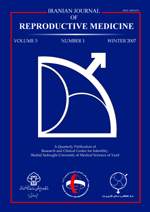
|
International Journal of Reproductive BioMedicine
Research and Clinical Center for Infertility, Shahid Sadoughi University of Medical Sciences of Yazd
ISSN: 1680-6433
EISSN: 1680-6433
Vol. 10, No. 4, 2012, pp. 297-302
|
 Bioline Code: rm12042
Bioline Code: rm12042
Full paper language: English
Document type: Research Article
Document available free of charge
|
|
|
International Journal of Reproductive BioMedicine, Vol. 10, No. 4, 2012, pp. 297-302
| en |
Outcome of cryopreserved-thawed embryo transfer in the GnRH agonist versus antagonist protocol
Eftekhar, Maryam; Firouzabadi, Razieh Dehghani; Karimi, Hesamoddin & Rahmani, Elham
Abstract
Background: GnRH agonist and antagonist were developed to control the premature release of LH surge. There is some difference between two protocols.
Objective: We compared the outcome of frozen-thawed embryo transfer in infertile women who used GnRH agonist or antagonist protocol for previous COH cycle and evaluation of any adverse effect of GnRH antagonist on oocyte and embryo.
Materials and Methods: The study group included all infertile women who referred to Yazd Research and Clinical Center for Infertility. Overall 20-35 years old women who were candidate for frozen-thawed embryo transfer with regard to inclusion and exclusion criteria were participated in the study. The patients based on previous control ovarian stimulation (COH) protocol divided in to two groups: GnRH agonist long protocol (n=165) and GnRH antagonist multiple dose protocol (n=165). Frozen-thawed embryos were transferred after endometrial preparation in both groups. Main outcome measures were: implantation, chemical and clinical pregnancy rate.
Results: The implantation and clinical pregnancy rate following cryopreserved embryo transfer in GnRH agonist group and antagonist group were 16.3% vs. 15.7% (p=0.806) and 38.1% (63/165) vs. 36.9% (61/165) (p=0.915) and chemical pregnancy rate was 44.8% (74/165) vs. 43.6% (72/165) (p=0.915) respectively.
Conclusion: There was no statistically difference between two groups in terms of implantation and pregnancy rate. Although pregnancy rate in fresh embryo transfer in antagonist cycles was lower than agonist groups, Therefore decrease in these parameters might be due to detrimental effect of GnRH antagonist on the endometrium, not embryo or oocyte.
Keywords
GnRH agonist, GnRH antagonist, Cryopreserved, Embryo transfer, Pregnancy outcome.
|
| |
© Copyright 2012 - Iranian Journal of Reproductive Medicine
Alternative site location: http://www.ijrm.ir
|
|
